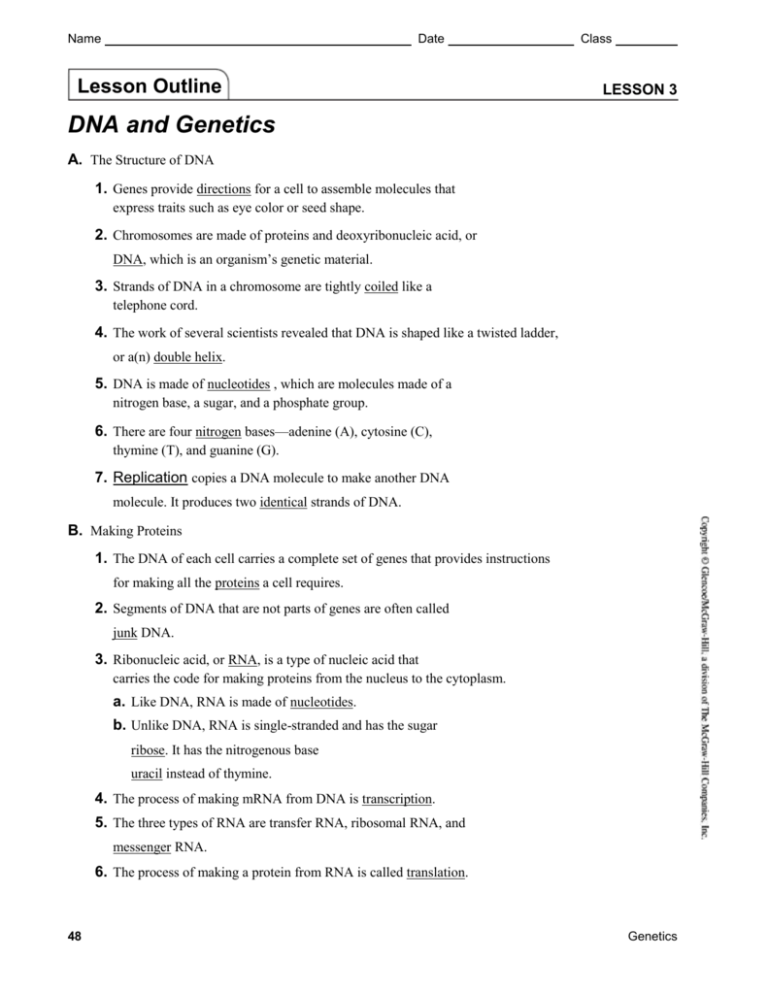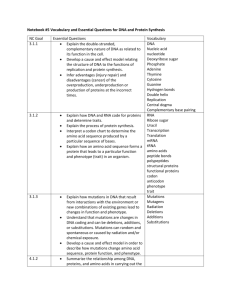Lesson 3 outline with answers
advertisement

Name Date Lesson Outline Class LESSON 3 DNA and Genetics A. The Structure of DNA 1. Genes provide directions for a cell to assemble molecules that express traits such as eye color or seed shape. 2. Chromosomes are made of proteins and deoxyribonucleic acid, or DNA, which is an organism’s genetic material. 3. Strands of DNA in a chromosome are tightly coiled like a telephone cord. 4. The work of several scientists revealed that DNA is shaped like a twisted ladder, or a(n) double helix. 5. DNA is made of nucleotides , which are molecules made of a nitrogen base, a sugar, and a phosphate group. 6. There are four nitrogen bases—adenine (A), cytosine (C), thymine (T), and guanine (G). 7. Replication copies a DNA molecule to make another DNA molecule. It produces two identical strands of DNA. B. Making Proteins 1. The DNA of each cell carries a complete set of genes that provides instructions for making all the proteins a cell requires. 2. Segments of DNA that are not parts of genes are often called junk DNA. 3. Ribonucleic acid, or RNA, is a type of nucleic acid that carries the code for making proteins from the nucleus to the cytoplasm. a. Like DNA, RNA is made of nucleotides. b. Unlike DNA, RNA is single-stranded and has the sugar ribose. It has the nitrogenous base uracil instead of thymine. 4. The process of making mRNA from DNA is transcription. 5. The three types of RNA are transfer RNA, ribosomal RNA, and messenger RNA. 6. The process of making a protein from RNA is called translation. 48 Genetics Name Date Lesson Outline continued 7. The order of the nitrogen bases in mRNA determines the order of the amino acids in a protein. 8. Each series of three nitrogen bases on mRNA is called a(n) codon. a. Most codons code for amino acids . b. One of the codons codes for an amino acid that is at the beginning of a protein. This codon signals that translation should start. Three of the codons do not code for any amino acid. Instead, they code for the end of the protein. C. Mutations 1. A change in the nucleotide sequence of a gene is a(n) mutation. 2. Mutations can be triggered by exposure to X-rays, ultraviolet light, radioactive materials, and some kinds of chemicals. 3. Types of DNA mutations include deletion mutations, insertion mutations, and substitution mutations. 4. Each type of mutation changes the sequence of nitrogen base pairs, which can cause a gene to code for a different protein than a normal gene. 5. Because mutations can change proteins, they can change traits. 6. Mutations can have negative effects, positive effects, or no effect on traits. s Class









